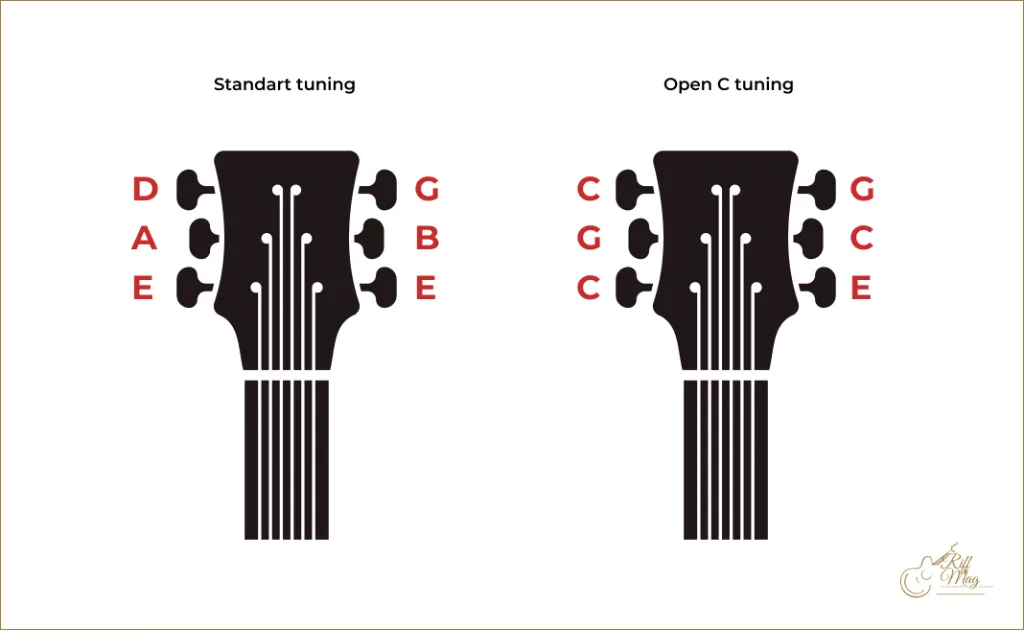As a guitar player seeking to broaden your musical horizons and explore new techniques, one approach worth considering is open guitar tuning.
This comprehensive guide delves into the open guitar tuning, covering its advantages, applications, the various types available, and how to select the right one for your needs.
Both novices and experienced guitarists can benefit from mastering the basics of open guitar tuning, as it can unlock your creative potential and elevate your guitar playing.
What is open guitar tuning?
Open guitar tuning is a technique in which the guitar strings form a chord when played without fretting any notes. Unlike standard E-A-D-G-B-E tuning, open guitar tuning can involve any combination of notes.
The benefits of open tuning
Open guitar tuning offers numerous advantages, including:
Unique chord voicings with open guitar tuning
Open guitar tuning enables the strings to form chords when played openly, resulting in voicings that are unattainable in standard tuning. This encourages a fresh approach to the instrument, sparking creativity and leading to distinctive sounds and styles.
Easier chord playing in open guitar tuning
Open guitar tuning often requires just one or two fingers to form chords, simplifying complex chord progressions. This is particularly helpful for beginners still building finger strength and dexterity.
Expanded harmonic range with open guitar tuning
Open guitar tuning facilitates a wide array of harmonics, producing a richer, more resonant sound.
Increased versatility through open guitar tuning
Open guitar tuning is applicable across various music genres, such as blues, folk, and slide guitar, enabling you to play in diverse keys and modes, enhancing your adaptability as a musician and songwriter.
Improved slide playing with open guitar tuning
Slide guitar playing frequently employs open guitar tuning, as the open strings produce a drone-like effect that complements the sliding notes.
Greater creative freedom using open guitar tuning
Open guitar tuning encourages experimentation and creativity because it allows for unique and unconventional chord progressions and sounds. This can inspire new ideas and help you develop your own style and sound.
Popular open guitar tuning options to try
Numerous open guitar tuning options are available, each offering its distinct sound and playing style. Before attempting an alternate method, ensure your guitar is already tuned to standard tuning. Here you can find information on how to tune your acoustic guitar and electric guitar to standard tuning.
Here are a few examples of popular open guitar tuning options:
Open E tuning (E-B-E-G#-B-E)

Open E tuning is highly favored due to its similarity to E standard tuning, and it is frequently used in blues, rock, and country genres.
You can easily switch from Standard tuning to Open E.
Steps to tune your guitar with Open E:
- The low E string (6th string) remains unchanged
- Tune the A string (5th string) one whole step up to B
- Tune the D string (4th string) one whole step up to E
- Tune the G string (3rd string) half step up to G#
- The B string (2nd string) stays the same
- The high E string (1st string) stays the same
Songs you can play using Open E open guitar tuning:
- “Stuck In A Moment You Can’t Get Out Of” by U2
- “Strawberry Swing” by Coldplay
- “California” by Johny Mitchell
- “Gimme Shelter” by The Rolling Stones
- “You’re Gonna Make Me Lonesome When You Go” by Bob Dylan
Open A tuning (E-A-E-A-C#-E)

Open A tuning configures the guitar strings to form an A chord and is often used in blues and folk music. As a popular alternative tuning, it is relatively easy to adopt.
Steps to tune your guitar with Open A:
- The low E string (6th string) stays the same
- The A string (5th string) stays the same
- Tune the D string (4th string) one whole step up to E
- Tune the G string (3rd string) one whole step up to A
- Tune the B string (2nd string) one whole step up to C#
- The high E string (1st string) stays the same
Songs you can play in Open A tuning:
- “Start Me Up” by The Rolling Stones
- “Can’t You Hear Me Knocking” by The Rolling Stones
- “Kashmir” by Led Zeppelin
- “Iron Man” by Black Sabbath
- “Red House” by Jimi Hendrix
- “Lonely Years” by Eric Clapton
Open D tuning (D-A-D-F#-A-D)

Open D tuning is a favorite among slide guitar players due to the ease of sliding along the fretboard. It is frequently employed in blues, rock, and folk genres.
Steps to tune your guitar to Open D with open guitar tuning:
- Tune the low E string (6th string) one whole step down to D
- The A string (5th string) stays the same
- The D string (4th string) stays the same
- Tune the G string (3rd string) half step down to F#
- Tune the B string (2nd string) one whole step down to A
- The high E string (1st string) one whole step down to D
Songs you can play using Open D open guitar tuning:
- “Start Me Up” by The Rolling Stones
- “Loser” by Beck
- “Thunder” by Boys Like Girls
- ”Big Yellow Taxi” by Joni Mitchell
- ”Street Fighting Man”by The Rolling Stones
- ”Wasteland Baby” by Hozier
- ”Crippled Inside” by John Lennon
- ”Even Flow” by Pearl Jam
Open G tuning (D-G-D-G-B-D)

Open G tuning is a versatile and widely-used tuning in various genres and playing styles, such as blues, folk, and slide guitar.
Steps to tune your guitar with Open G:
- Tune the low E string (6th string) one whole step down to D
- Tune the A string (5th string) one whole step down to G
- The D string (4th string) stays the same
- The G string (3rd string) stays the same
- The B string (2nd string) stays the same
- The high E string (1st string) one whole step down to D
Songs you can play in Open G tuning:
- ”Muse” by Uprising
- ”Pearl Jam” by Daughter
- ”Simple Plan” by Perfect
- “Led Zeppelin” by That’s The Way
- ”Duffy” by Mercy
- ”The Rolling Stones” by Start Me Up
Open C tuning (C-G-C-G-C-E)

Open C tuning is primarily used with 12-string guitars, but it is also popular on six-string guitars. This tuning allows for effortless slide guitar playing and the creation of intricate fingerstyle arrangements.
Steps to tune your guitar with Open C:
- Tune the low E string (6th string) two whole steps down to C
- Tune the A string (5th string) one whole step down to G
- Tune the D string (4th string) one whole step down to C
- The G string (3rd string) stays the same
- Tune the B string (2nd string)one whole step up to C
- The high E string (1st string) stays the same
Songs you can play in Open C tuning:
- “Michael Jackson” by You Are Not Alone
- ”Soundgarden” by Burden In My Hand
- ”Led Zeppelin” by Friends
- ”In Flames” by Only For The Weak
- ”Hozier” by Shrike
| 6th string | 5th string | 4th string | 3rd string | 2nd string | 1st string | |
|---|---|---|---|---|---|---|
| Standard Tuning | low E | A | D | G | B | high E |
| Open E tuning | E | B | E | G# | B | E |
| Open A tuning | E | A | E | A | C# | E |
| Open D tuning | D | A | D | F# | A | D |
| Open G tuning | D | G | D | G | B | D |
| Open C tuning | C | G | C | G | C | E |
Conclusion:
Open guitar tunings provide an excellent opportunity to broaden your playing scope and discover new sounds on your instrument. Each tuning possesses a unique character and can be utilized to craft various musical styles.
Experimenting with open guitar tunings is an effective way for both beginners and seasoned players to extend their musical horizons and elevate their playing to new heights.

